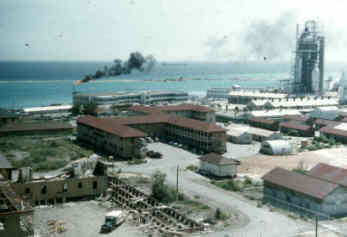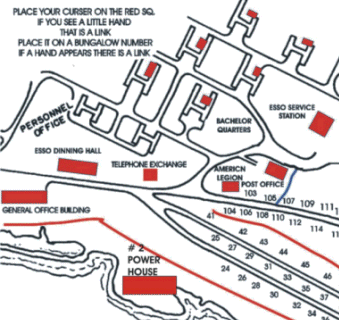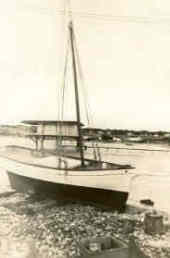|
BACKGROUNDS |
| The interesting thing I have found since beginning
this web site is the amount of information that is found in the
background of a lot of old photographs. The subject matter of the
original taker of the photograph had no idea that in later years the
background would be of interest to anyone. In the original photo
the background had nothing to do with the subject being photographed.
Now the
background, thanks to digital scanning and the computer, becomes
interesting and we can
extract from these old photos a window into what the Lago
Colony of by gone years looked like and the transformation that has
taken place over the past seventy-five years. |
| When Lago was a transshipping facility and
there were only storage tanks and the refinery was not begun, the Colony
of those days consisted of about 50 houses built along the cliff of the
Big Lagoon, very close to the docks used by the Lake Tankers. These houses were built for families of the English crews of
the Lake Tankers that carried the crude oil from Lake Maracaibo to Aruba
for shipment to refineries in Mexico and the United States. I am
sure the lactation had a lot to do with the fact that the men could walk
home from the ships. |
 There
is no photograph that I have found of these houses and their
relationship to the dock. However, the photograph at the right, from Donald
Rosborough father, was taken in 1934, after the refinery was built but
before the houses along the cliff were moved for refinery expansion.
Only when the refinery was made larger the houses were moved. There
is no photograph that I have found of these houses and their
relationship to the dock. However, the photograph at the right, from Donald
Rosborough father, was taken in 1934, after the refinery was built but
before the houses along the cliff were moved for refinery expansion.
Only when the refinery was made larger the houses were moved. |
  Using
the map at the right you can see that in the 1950's had another
photograph been taken from the same location as the black & white
photograph above, instead of seeing houses along the water's cliff in
the background, you
would see the General Office Building and the No. 2 Power House.
The color photograph to the left, from
BOB SCHLAGETER'S
collection, was taken in the 1950's from almost the same location as the
Black & White above, and it shows the General Office Building, Cat Cracker, Esso Dinning
Hall and the Lab. These buildings and units were all built on the land that was
occupied by the houses used by the first English families who came with
their husbands to man and skipper the Lake Tankers. Using
the map at the right you can see that in the 1950's had another
photograph been taken from the same location as the black & white
photograph above, instead of seeing houses along the water's cliff in
the background, you
would see the General Office Building and the No. 2 Power House.
The color photograph to the left, from
BOB SCHLAGETER'S
collection, was taken in the 1950's from almost the same location as the
Black & White above, and it shows the General Office Building, Cat Cracker, Esso Dinning
Hall and the Lab. These buildings and units were all built on the land that was
occupied by the houses used by the first English families who came with
their husbands to man and skipper the Lake Tankers.
|
| There is a gap between the area of the old
refinery and Colony and what was there in the late 1940's, after the
General Office Building and Cat Cracker were built. The next photo
shows the old refinery and part of what was housing outside the
refinery. |
| TO GO TO A LARGER VIEW OF THE
PHOTO CLICK ON THE PHOTO. |
|
 |
| Another example of what can be seen
in the background of photos is the green house on piles that was just
off the shore by the New Esso Club. You can also see some of the
other "shacks" or "party houses" that were located along the shore
between the New Esso Club and Rogers Beach. All these are now
gone. It is interesting to note that Reg Kennerty found the KLIM
can in the box in the foreground of this same photo of the boat.
There is a lot to be found in photos. |
|
   |
|
To see more about the Green House on
stilts, click on the photo of the house, above middle, and go to a page
about the house. |
|
Still another
example of what can be seen in the background of photos is this party
house which is found in the background of a photo from Don Blair.
The party house below is taken from the front yard of one of the
Bungalows on the lower road. This same Party House can be seen in
the photo above, to the right of the house over the water. |
|
 |
| I guess what background in photos show is the same
as the subject of the photograph shows, nothing remains the same, a
place changes, as seen in background, people change as can be seen in
the subject. The people in the background photos from Bill Moyer changed
just as the background changed. They lived, grew old and are now
gone. What I remember of Lago Colony was only a snapshot of the
place, from about 1950 to 1957, the time when I really began to
understand place and time. I lived in Lago Colony from 1938 until
1957 but in my early years I did not relate or remember that much about
the Colony. There was no Cat Cracker when I went to Aruba but I
always remember a Cat Cracker, now there is no Cat Cracker, things
change. Today in Seroe Colorado, much of what you see on this web
site is gone, however, much remains and fifty years from now the
photographs people are taking today will show a much different
background that what will be there in fifty years. |
|
CLICK HERE
TO SEE MORE BACKGROUNDS IN OLD PHOTOGRAPHS. |
 There
is no photograph that I have found of these houses and their
relationship to the dock. However, the photograph at the right, from Donald
Rosborough father, was taken in 1934, after the refinery was built but
before the houses along the cliff were moved for refinery expansion.
Only when the refinery was made larger the houses were moved.
There
is no photograph that I have found of these houses and their
relationship to the dock. However, the photograph at the right, from Donald
Rosborough father, was taken in 1934, after the refinery was built but
before the houses along the cliff were moved for refinery expansion.
Only when the refinery was made larger the houses were moved.
 Using
the map at the right you can see that in the 1950's had another
photograph been taken from the same location as the black & white
photograph above, instead of seeing houses along the water's cliff in
the background, you
would see the General Office Building and the No. 2 Power House.
The color photograph to the left, from
BOB SCHLAGETER'S
collection, was taken in the 1950's from almost the same location as the
Black & White above, and it shows the General Office Building, Cat Cracker, Esso Dinning
Hall and the Lab. These buildings and units were all built on the land that was
occupied by the houses used by the first English families who came with
their husbands to man and skipper the Lake Tankers.
Using
the map at the right you can see that in the 1950's had another
photograph been taken from the same location as the black & white
photograph above, instead of seeing houses along the water's cliff in
the background, you
would see the General Office Building and the No. 2 Power House.
The color photograph to the left, from
BOB SCHLAGETER'S
collection, was taken in the 1950's from almost the same location as the
Black & White above, and it shows the General Office Building, Cat Cracker, Esso Dinning
Hall and the Lab. These buildings and units were all built on the land that was
occupied by the houses used by the first English families who came with
their husbands to man and skipper the Lake Tankers.




